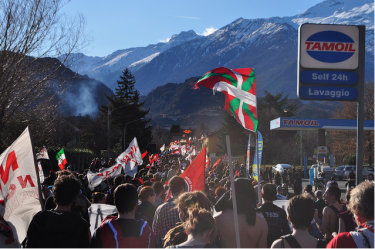[all links in Italian unless otherwise indicated]
The debate surrounding the construction of a new railway line linking Turin to Lyon [en], which faces fierce opposition from the “No to Tav” movement, has turned increasingly bitter and an upsurge in protests has brought the affair into the political and media spotlight.
Since 1991, this protest movement, made up mainly of inhabitants of Valle di Susa in Piemonte, has opposed the construction of a high speed (treno altà velocità, or TAV, in Italian) railway line between Turin and Lyon. According to its opponents, the TAV project is not only pointless and costly but will also prove environmentally, socially and economically damaging to the area and its inhabitants, given that construction of the railway line will destroy a wide swathe of the countryside, leaving several villages changed beyond all recognition and resulting in the closure of small local businesses.
The Italian government and the European Union are determined to press ahead with what they consider a strategic project, as it will eventually link Northern Italy with Eastern Europe. The mayors and inhabitants of the communities affected insist that the construction of a new railway line is completely unjustifiable, given that goods traffic on the existent line is minimal. The project is due to cost the Italian state 30 million euro at a time when its citizens are tightening their belts in response to the current crisis.
Suppression of the opposition movement by the forces of order has been particularly severe over the last few months. Following clashes last summer, work on the railway line was restarted on February 27 with the eviction of protesters from their camp and the fencing off of private land without due legal process.

A "No TAV" march, 25/02/2012, from Bussoleno to Susa. Photo reproduced under Creative Commons License BY-SA
During a recent demonstration against the dismantlement of the movement's camp, one of the best known members of the movement, Luca Abbà, was badly injured when he fell off a pylon, from a height of around ten metres. As a result, a halt to construction was requested. In the video which follows, which is also available on the YouReporter.it website, police officers burst into a bar after demonstrators blocked off a motorway, and proceeded to ID everyone present.
http://www.youtube.com/watch?v=ltFytXSsT6s
Police action of this kind and attempts in the national media to characterise opponents of the TAV as “violent”, have been interpreted by many netizens as a excuse to delegitimise the movement as a whole. On his blog Le Parole e le Cose (Words and Things), for example, Mauro Piras writes:
Il problema non è più prendere posizione. Pro o contro la TAV (o il TAV? la divisione passa anche per le parole, i No TAV della valle usano il maschile). E non è neanche quello dei “gruppetti di violenti” contrapposti alla “maggioranza dei manifestanti pacifici”. Questa rappresentazione è ingenua, o costruita. C’è qualcosa di più profondo, qualcosa che sfugge a noi quarantenni della classe media di, diciamo, centrosinistra
The debate has, by now, spread throughout the country, moving from centri sociali (non-profit community spaces, used for a variety of local activities and often centres of political and social dissent) [en] to schools. Students have also decided to demonstrate, as explained on the website Rete della conoscenza (Web of Knowledge):
Crediamo che quest'operazione della polizia avesse come unico obiettivo quello di criminalizzare e screditare un movimento che aveva organizzato una grande manifestazione pacifica (…).
La battaglia No Tav, non è solo una lotta di un popolo in difesa di una valle ma è una lotta di tutti coloro che credono che il territorio sia un bene comune da difendere e non da sfruttare per interessi economici, per questo torneremo in Val Susa e saremo sempre al fianco di chi lotta contro le opere inutili.
The battle against the TAV isn't just for people fighting to defend their valley but for everyone who believes that the countryside is communal heritage to be defended and not to be milked for economic gain, it's for this reason that we will go back to the Val Susa and we will always stand alongside those who fight unnecessary development.
The Twitter debate has also been very heated. One of the critics of the the “No TAV” movement, @Axell, writes:
Gli studenti NO TAV dei licei che oggi hanno bloccato Porta Nuova e zone limitrofe sanno dove è la Val di Susa? #SiTav #aveterottoleballe
Among its supporters, however, were @fulviomassa:
“inizia ora la passeggiata verso la Baita Clarea” [where TAV construction work was due to start] forza!
Antonio Ballestrazzi @pesce2802:
#sitav #notav spiegatemi bene,per migliorare il trasporto delle merci prosciughiamo i fiumi che servono a irrigare i campi che le producoono
ma com'è possibile che pure a un sondaggio mediaset il 70% sono #notav e in parlamento e sui giornali sono tutti #sitav? fatevi due domande
Reasons for expressing solidarity with the demonstrators varied. The No Tav movement was placed in the context of the current crisis in Europe [en] on the blog Uninomade:
Il No Tav è un movimento dentro la crisi e contro l’austerity, i suoi temi centrali sono dichiaratamente la lotta ai tagli, al debito e sul welfare. Non contro lo sviluppo e la modernità, ma per lo sviluppo dell’autonomia della cooperazione sociale contro lo sviluppo capitalistico che tenta di imbrigliarla o distruggerla.
Antonio Negri, issued the following invitation to dialogue, which compares the movement to the global Occupy [en] movement:
Qualsiasi persona calma e tranquilla che non viva nel ricordo ossessivo degli anni ’70 come certi nostri dirigenti sembrano vivere, sa che trattare è possibile ed evitare radicalizzazioni inopportune e pericolose è utile. Ma per farlo bisogna che la politica in Italia rinasca e non può rinascere che dalla presa di parola di coloro che, resistendo, aprono a tutti la speranza di una nuova partecipazione democratica.
Throughout the country, solidarity with, and and actions in support of the Valle di Susa, have emerged, including the “Blocchiamo tutto” (Blockade Everything) initiative on the 1st of March when the main stations in Rome and Bologna and other key railway intersections were blockaded. Meanwhile demonstrations in support of the movement have spread across Europe, including to the French end of the proposed Turin-Lyon line.
Anonymous Italia, a hacker collective, has also swung into action, first blocking access to the Carabinieri's website and then to the official sites of the government, the Vatican, Trenitalia [National railway company] and Equitalia [National fine collector agency]. Below are some reactions to their actions:
Baruda:
#Anonymous e #Trenitalia: niente da fare, io li amo! TANGO DOWN #OpItaly wp.me/pfk0G-2dj #notav
#Anonymous and #Trenitalia: no bones about it, I love them TANGO DOWN #OpItaly wp.me/pfk0G-2dj #notav
andrea_nicolini:
@Skytg24: #Anonymous attacca #Trenitalia.it: tra il tilt e la normale fruibilita’ del sito nessuna differenza…
Info Free Flow:
Oggi paga #equitalia. #Anonymous riscuote. Ma i conti non sono ancora saldati. pastebin.com/BSX9gNs7
While the judiciary is investigating several demonstrators, charged after the most recent protests, the affair remains uncertain and controversial. The hashtag #notav is more popular on Twitter, while I Fratelli di TAV (Brothers of the TAV) are uploading a series of videos on Vimeo about the movement's history, events and dynamics, including the following video of the blockade, on the 29th of February this year, of the Turin to Bardonecchia motorway:







